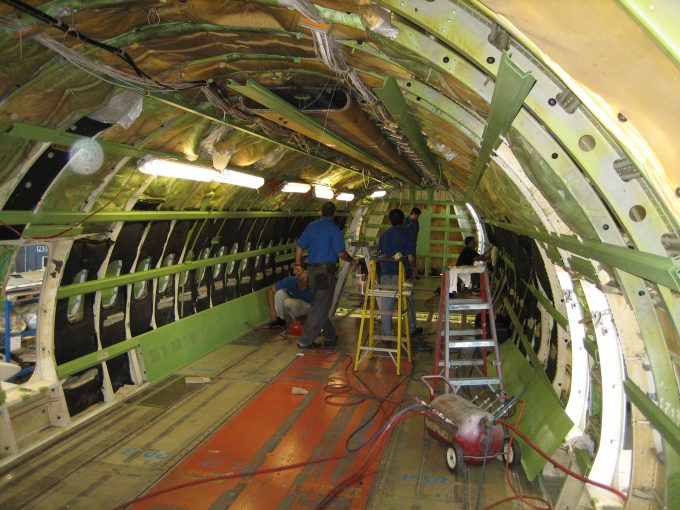Challenge Group sources new aircraft as Jet's 777s remain elusive
Challenge Group has found another aircraft for its early February conversion slot, as it continues ...
GM: RAISING THE ROOF GGM: IN FULL THROTTLE GZIM: MAERSK BOOST KNIN: READ-ACROSSMAERSK: NOT ENOUGHMAERSK: GUIDANCE UPGRADEZIM: ROLLERCOASTERCAT: HEAVY DUTYMAERSK: CATCHING UP PG: DESTOCKING PATTERNSPG: HEALTH CHECKWTC: THE FALLGXO: DEFENSIVE FWRD: RALLYING ON TAKEOVER TALKODFL: STEADY YIELDVW: NEW MODEL NEEDEDWTC: TAKING PROFIT
GM: RAISING THE ROOF GGM: IN FULL THROTTLE GZIM: MAERSK BOOST KNIN: READ-ACROSSMAERSK: NOT ENOUGHMAERSK: GUIDANCE UPGRADEZIM: ROLLERCOASTERCAT: HEAVY DUTYMAERSK: CATCHING UP PG: DESTOCKING PATTERNSPG: HEALTH CHECKWTC: THE FALLGXO: DEFENSIVE FWRD: RALLYING ON TAKEOVER TALKODFL: STEADY YIELDVW: NEW MODEL NEEDEDWTC: TAKING PROFIT

Hit by a perfect storm, freighter conversions have slowed from frantic activity to reducing conversion lines.
Orders are down, while feedstock is scant and expensive as rampant demand for passenger planes hoovers-up available aircraft.
Narrowbody conversion specialist Aeronautical Engineers (AEI) has secured orders from two clients for four B737-800 reconfigurations in the past two days, but overall, business has slowed significantly, reported Bob Convey, VP of sales and marketing.
He reckons the company will complete 25 conversions this year – last year it finished 42 –and pointed to a combination of very expensive feedstock to non-existent feedstock on one side, and lack of demand on the other.
The days when airlines and leasing firms were rushing to turn their idle passenger planes into all-cargo configuration are a distant memory. Now there is a scramble for passenger aircraft, as recovering travel demand triggers massive schedule expansions.
Delta, for example, is upping its transatlantic flying this summer by 30%, to operate 77 routes to 32 destinations in Europe and beyond.
Airlines are placing large orders for new aircraft: last month, Turkish Airlines announced plans to buy 600, smashing the record set this year by Air India’s order for 470. Observers have likened the rush for aircraft to an “arms race” among carriers.
Manufacturers, meanwhile, are unable to meet demand. Boeing suffered hiccups on its production lines of B787s and 737s, but those were temporary setbacks. The bigger headache for aircraft makers has been issues with supply chains, and those are not going to be rectified by short-term fixes.
Boeing CEO Dave Calhoun said this month that efforts to fix supply chain problems had shown “frustratingly slow” progress and he warned that aircraft production capacity would remain constrained for five years.
Rival Airbus is in a similar predicament. Narrowbody aircraft deliveries are 40% down on pre-Covid numbers, again largely due to supply chain issues.
So with output of new aircraft hobbled, carriers are now competing to snap-up second-hand planes. Last month, Lufthansa obtained four retired LATAM A350s and two more A350s from Philippine Airlines, while Air Canada has leased two used A330s to use until it receives aircraft it has ordered.
Aircraft leasing firms are enjoying strong demand for passenger planes. Quite a few leases have been extended – not just by six months but from three to five years, Mr Convey said. And their leasing rates, which trailed freighter rates during the pandemic, have surged well ahead, a gap likely to widen in the coming months, he added.
“Lessors have cooled-off on freighters,” he said. “They were doing conversions on spec. Why would they spend time and money on converting a plane if they can make more money in the passenger business?”
As a result, feedstock for conversions has shrunk alarmingly, leading to “a dramatic lack of feedstock to be purchased at any price” said Mr Convey. “There are very few passenger [B737-]800s on the market, and the ones that are listed for sale are either in poor condition or priced out of the range of most freighter dogs.”
Purchase prices of 737-800s have increased 20%-30% over the past six months, he added.
While feedstock is depleted, demand has also waned, and the integrators have slowed down their aircraft purchases. FedEx is actually shrinking its fleet in response to a marked shift in traffic to deferred delivery windows Mr Convey noted. For aircraft conversion specialists, the gold rush days of the pandemic are over, for now.
“A year ago we were booked almost two years out, now we could drop in a -800 in July,” he said. “It’s getting back to what we were used to before the pandemic.”
Comment on this article